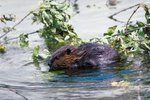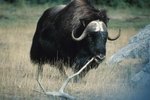
Arctic wolves (Canis lupus arctos) are not their own individual species, but rather a gray wolf (Canis lupus) subspecies. They reside in the extreme northern portions of Canada -- think Ellesmere Island, to be specific -- and Greenland. Other common monikers for the subspecies are white wolf and polar wolf.
Background Information
Arctic wolves possess off-white fur, which effortlessly blends in with their wintry landscapes, hence their aforementioned "white wolf" handle. They are not as sizable as the average gray wolf. Arctic wolves, in maturity, typically weigh between 99 and 154 pounds. They also generally grow to between 3 and 6 feet long, which takes their tails into consideration. As highly social creatures, they usually stay in packs, although some live all by their lonesome. They do not generally search for food alone, but rather with the rest of their pack. Because arctic wolves are practically never near humans, hunting isn't really an issue for them. People also don't usually interfere with their natural living environments. Arctic wolf youngsters enter the world every year from the end of May into the beginning of June.
Prey
Arctic wolves are meat eaters through and through. Their most common prey targets are caribou, arctic hares, lemmings and musk ox. They're not afraid to go after creatures that are markedly bigger than them, notably caribou. Other components of their diet are birds, such as ptarmigans, and seals. Arctic wolves attack their next meal by sinking their teeth into a prey animal's neck. They tend to consume their food in massive pieces, with not a lot of chewing action at all.
Weather Swings
Weather swings can have a negative effect on arctic wolves as a species. Major shifts in weather can be troubling for arctic hares and and musk ox, as they can lead to problems in tracking down sustenance, which can ultimately trigger drops in their population. This also is seriously bad news for arctic wolves. Since arctic hares and musk ox are some of their favored prey, it means, plain and simple, a lot less food to go around for them, too.
Not a Lot of Prey Around Them
The vast Arctic, where these wolves live, doesn't have high concentrations of prey animals. To get around this obstacle, arctic wolves have extremely large stomping grounds, usually well over 1,000 square miles.
References
Photo Credits
-
Jupiterimages/Photos.com/Getty Images




